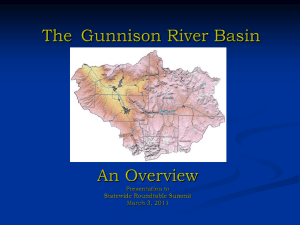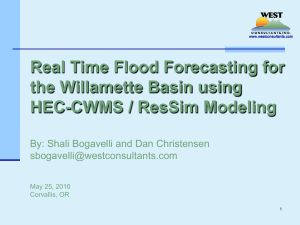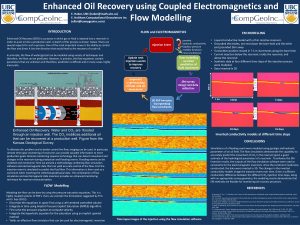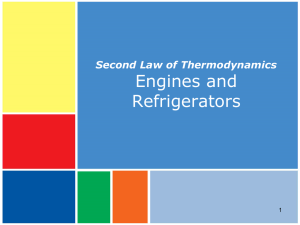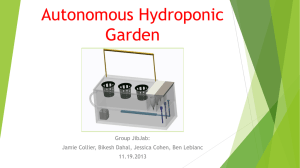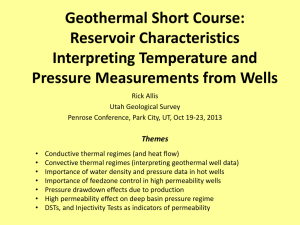INTRODUCTION TO RESERVOIR ENGINEERING
advertisement
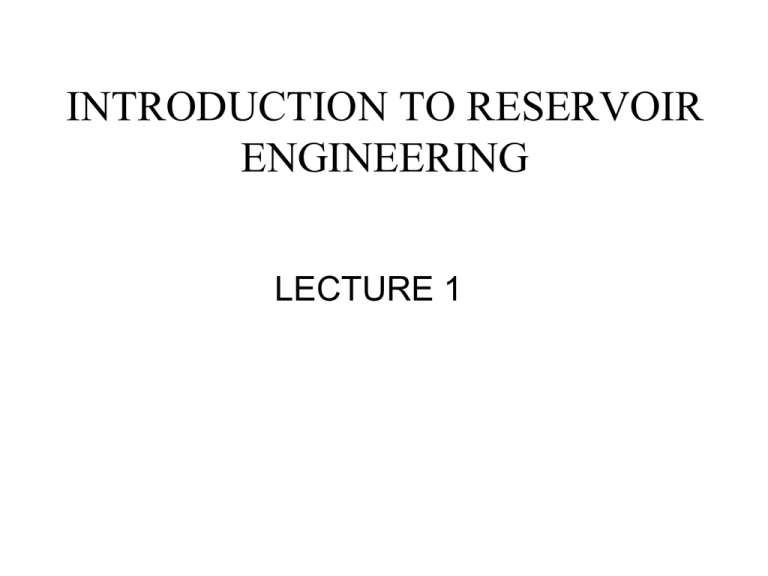
INTRODUCTION TO RESERVOIR ENGINEERING LECTURE 1 CLASSIFICATION OF RESERVOIRS AND RESERVOIR FLUIDS Petroleum reservoirs are broadly classified as oil or gas reservoirs. These broad classifications are further subdivided depending on: • The composition of the reservoir hydrocarbon mixture • Initial reservoir pressure and temperature • Pressure and temperature of the surface production The conditions under which these phases exist are a matter of considerablepractical importance. The experimental or the mathematical determinations of these conditions are conveniently expressed in different types of diagrams commonly called phase diagrams. One such diagram is called the pressuretemperature diagram. Pressure-Temperature Diagram Figure 1-1 shows a typical pressure-temperature diagram of a multicomponent system with a specific overall composition. Although a different hydrocarbon system would have a different phase diagram, the general configuration is similar. These multicomponent pressure-temperature diagrams are essentially used to: • Classify reservoirs • Classify the naturally occurring hydrocarbon systems • Describe the phase behavior of the reservoir fluid Petroleum Geology LECTURE 2 1 How is petroleum formed? Petroleum is result of the deposition of plant or animal matter in areas which are slowly subsiding.These areas are usually in the sea or along its margins in coastal lagoons or marshes,occasionally in lakes or inland swamps.Sediments are deposited along with that at least part of the organic matter is preserved by burial before being destroyed by decay.As time goes on and the areas continue to sink slowly,the organic material is buried deeper an hence is exposed to higher temperatures and pressures.Eventually chemical changes result in the generation of petroleum,a complex,highly variable mixture lf hydrocarbons. 2 what is “trap” ? The term “trap” was first applied to a hydrocarbon accumulation by Orton: “…stocks of oil and gas might be reapped in the summits of folds or arches found along their wat to higher ground .”A detailed historical account of the subsequent evolution of the concept and etymology of the term trap is found in Dott and Reyonlds(1969). 3 where can we find petroleum ? Hydrocarbons—crude oil and natural gas—are found in certain layers of rock that are usually buride deep beneath the surface of the earth. Basic Concepts of Origin, Accumulation and Recovery of Hydrocarbons LECTURE 3 常 规 型 游 梁 式 抽 油 机 旋 转 驴 头 游 梁 式 抽 油 机 异 型 游 梁 式 抽 油 机 调 径 变 矩 游 梁 式 抽 油 机 链传式抽油机 天轮式抽油机 直线往复式抽油机 链条式抽油机 皮带式抽油机 Elements of Petroleum Reservoir ---fluid content of the reservoir LECTURE 4 Porosity and Effective Porosity LECTURE 5 POROSITY • For rock to contain petroleum and later allow petroleum to flow,it must have certain physical characteristics. Obvilusly, there must be some spaces in the rock in which the petroleum can be stored. • If rock has openings,voids,and spaces in which liquid and gas may be stored,it is said to be porous .For a given volume of rock, the ratio of the open space to the total volume of the rock is called porosity,the porosity may be expressed a decimal fraction but is most often expressed as a percentage.For example,if 100 cubic feet of rock contains many tiny pores and spaces which together have a volume of 10 cubic feet, the porosity of the rock is 10%. POROSITY The porosity of a rock is a measure of the storage capacity (pore volume)that is capable of holding fluids. Quantitatively, the porosity is the ratio of the pore volume to the total volume (bulk volume). This important rock property is determined mathematically by the following generalized relationship: where f = porosity POROSITY As the sediments were deposited and the rocks were being formed during past geological times, some void spaces that developed became isolated from the other void spaces by excessive cementation. Thus, many of the void spaces are interconnected while some of the pore spaces arecompletely isolated. This leads to two distinct types of porosity, namely: • Absolute porosity • Effective porosity Absolute porosity The absolute porosity is defined as the ratio of the total pore space in the rock to that of the bulk volume. A rock may have considerable absolute porosity and yet have no conductivity to fluid for lack of pore interconnection. The absolute porosity is generally expressed mathematically by the following relationships: or where fa = absolute porosity. Effective porosity The effective porosity is the percentage of interconnected pore space with respect to the bulk volume, or where f = effective porosity. One important application of the effective porosity is its use in determining the original hydrocarbon volume in place. Consider a reservoir with an areal extent of A acres and an average thickness of h feet. The total bulk volume of the reservoir can be determined from the following expressions: Bulk volume = 43,560 Ah, ft3 or Bulk volume = 7,758 Ah, bbl where A = areal extent, acres h = average thickness Permeability and Darcy’s Law LECTURE 6 PERMEABILITY Permeability is a property of the porous medium that measures the capacity and ability of the formation to transmit fluids. The rock permeability, k, is a very important rock property because it controls the directional movement and the flow rate of the reservoir fluids in the formation. This rock characterization was first defined mathematically by Henry Darcy in 1856. In fact, the equation that defines permeability in terms of measurable quantities is called Darcy’s Law. Darcy developed a fluid flow equation that has since become one of the standard mathematical tools of the petroleum engineer. If a horizontal linear flow of an incompressible fluid is established through a core sample of length L and a cross-section of area A, then the governing fluidflow equation is defined as where n = apparent fluid flowing velocity, cm/sec k = proportionality constant, or permeability, Darcys m = viscosity of the flowing fluid, cp dp/dL = pressure drop per unit length, atm/cm The apparent velocity determined by dividing the flow rate by the cross-sectional area across which fluid is flowing. Substituting the relationship, q/A, in place of n in Equation 3-21 and solving for q results in where q = flow rate through the porous medium, cm3/sec A = cross-sectional area across which flow occurs, cm2 One Darcy is a relatively high permeability as the permeabilities of most reservoir rocks are less than one Darcy. In order to avoid the use of fractions in describing permeabilities, the term millidarcy is used. As the term indicates, one millidarcy, i.e., 1 md, is equal to one-thousandth of one Darcy or, 1 Darcy = 1000 md The negative sign in Equation is necessary as the pressure increases in one direction while the length increases in the opposite direction. Integrate the above equation Linear flow model where L = length of core, cm A = cross-sectional area, cm2 The following conditions must exist during the measurement of permeability: • Laminar (viscous) flow • No reaction between fluid and rock • Only single phase present at 100% pore space saturation This measured permeability at 100% saturation of a single phase is called the absolute permeability of the rock. For a radial flow, Darcy’s equation in a differential form can be written as: Intergrating Darcy’s equation gives: The term dL has been replaced by dr as the length term has now become a radius term. Saturation LECTURE 7 SATURATION Saturation is defined as that fraction, or percent, of the pore volume occupied by a particular fluid (oil, gas, or water). This property is expressed mathematically by the following relationship: Applying the above mathematical concept of saturation to each reservoir fluid gives where So = oil saturation Sg = gas saturation Sw = water saturation Sg + So + Sw = 1.0 Critical oil saturation, Soc For the oil phase to flow, the saturation of the oil must exceed a certain value which is termed critical oil saturation. At this particular saturation, the oil remains in the pores and, for all practical purposes, will not flow. Residual oil saturation, Sor During the displacing process of the crude oil system from the porous media by water or gas injection (or encroachment) there will be some remaining oil left that is quantitatively characterized by a saturation value that is larger than the critical oil saturation. This saturation value is called the residual oil saturation, Sor. The term residual saturation is usually associated with the nonwetting phase when it is being displaced by a wetting phase. Movable oil saturation, Som Movable oil saturation Som is another saturation of interest and is defined as the fraction of pore volume occupied by movable oil as expressed by the following equation: Som = 1 - Swc - Soc where Swc = connate water saturation Soc = critical oil saturation Critical gas saturation, Sgc As the reservoir pressure declines below the bubble-point pressure, gas evolves from the oil phase and consequently the saturation of the gas increases as the reservoir pressure declines. The gas phase remains immobile until its saturation exceeds a certain saturation, called critical gas saturation, above which gas begins to move. Critical water saturation, Swc The critical water saturation, connate water saturation, and irreducible water saturation are extensively used interchangeably to define the maximum water saturation at which the water phase will remain immobile. Capillary Pressure and Its Curve LECTURE 8 Capillary pressure If a glass capillary tube is placed in a large open vessel containing water, the combination of surface tension and wettability of tube to water will cause water to rise in the tube above the water level in the container outside the tube as shown in Figure 3. The water will rise in the tube until the total force acting to pull the liquid upward is balanced by the weight of the column of liquid being supported in the tube. Figure 3 CAPILLARY PRESSURE The capillary forces in a petroleum reservoir are the result of the combined effect of the surface and interfacial tensions of the rock and fluids, the pore size and geometry, and the wetting characteristics of the system. Any curved surface between two immiscible fluids has the tendency to contract into the smallest possible area per unit volume. This is true whether the fluids are oil and water, water and gas (even air), or oil and gas. When two immiscible fluids are in contact, a discontinuity in pressure exists between the two fluids, which depends upon the curvature of the interface separating the fluids. We call this pressure difference the capillary pressure and it is referred to by pc. Capillary pressure = (pressure of the nonwetting phase) - (pressure of the wetting phase) pc = pnw - pw Figure4 Transition Zone The figure indicates that the saturations are gradually changing from 100% water in the water zone to irreducible water saturation some vertical distance above the water zone. This vertical area is referred to as the transition zone, which must exist in any reservoir where there is a bottom water table. The transition zone is then defined as the vertical thickness over which the water saturation ranges from 100% saturation to irreducible water saturation Swc. Water Oil Contact The WOC is defined as the “uppermost depth in the reservoir where a 100% water saturation exists.” Gas Oil Contact The GOC is defined as the “minimum depth at which a 100% liquid, i.e., oil + water, saturation exists in the reservoir.” Figure 5 It should be noted that there is a difference between the free water level (FWL) and the depth at which 100% water saturation exists. From a reservoir engineering standpoint, the free water level is defined by zero capillary pressure. Obviously, if the largest pore is so large that there is no capillary rise in this size pore, then the free water level and 100% water saturation level, i.e., WOC, will be the same. Wettabiloity and Distribution of Reservoir Fluids LECTURE 9 WETTABILITY Wettability is defined as the tendency of one fluid to spread on or adhere to a solid surface in the presence of other immiscible fluids. The concept of wettability is illustrated in Figure1. Small drops of three liquids-mercury, oil, and water—are placed on a clean glass plate. The three droplets are then observed from one side as illustrated in Figure 3-1. It is noted that the mercury retains a spherical shape, the oil droplet develops an approximately hemispherical shape, but the water tends to spread over the glass surface. The tendency of a liquid to spread over the surface of a solid is an indication of the wetting characteristics of the liquid for the solid. This spreading tendency can be expressed more conveniently by measuring the angle of contact at the liquid-solid surface. This angle, which is always measured through the liquid to the solid, is called the contact angle q. The contact angle q has achieved significance as a measure of wettability. As shown in Figure 1, as the contact angle decreases, the wetting characteristics of the liquid increase. Complete wettability would be evidenced by a zero contact angle, and complete nonwetting would be evidenced by a contact angle of 180°. There have been various definitions of intermediate wettability but, in much of the published literature, contact angles of 60° to 90° will tend to repel the liquid. The wettability of reservoir rocks to the fluids is important in that the distribution of the fluids in the porous media is a function of wettability. Because of the attractive forces, the wetting phase tends to occupy the smaller pores of the rock and the nonwetting phase occupies the more open channels. Properties of Natural Gas LECTURE 10 PVT Behaviour LECTURE 11 Classification of Hydrocarbon Reservoir LECTURE 12 CLASSIFICATION OF RESERVOIRS AND RESERVOIR FLUIDS Petroleum reservoirs are broadly classified as oil or gas reservoirs. • The composition of the reservoir hydrocarbon mixture • Initial reservoir pressure and temperature pressure-temperature diagram Pressure-Temperature Diagram Figure 1-1 shows a typical pressure-temperature diagram of a multicomponent system with a specific overall composition. Although a different hydrocarbon system would have a different phase diagram, the general configuration is similar. These multicomponent pressure-temperature diagrams are essentially used to: • Classify reservoirs • Classify the naturally occurring hydrocarbon systems • Describe the phase behavior of the reservoir fluid Pressure-Temperature Diagram • Critical point—The critical point for a multicomponent mixture is referred to as the state of pressure and temperature at which all intensive properties of the gas and liquid phases are equal (point C). At the critical point, the corresponding pressure and temperature are called the critical pressure pc and critical temperature Tc of the mixture. Pressure-Temperature Diagram • Bubble-point curve—The bubble-point curve (line BC) is defined as the line separating the liquid-phase region from the two-phase region. • Dew-point curve—The dew-point curve (line AC) is defined as the line separating the vapor-phase region from the two-phase region. Pressure-Temperature Diagram • Oil reservoirs—If the reservoir temperature T is less than the critical temperature Tc of the reservoir fluid, the reservoir is classified as an oil reservoir. • Gas reservoirs—If the reservoir temperature is greater than the critical temperature of the hydrocarbon fluid, the reservoir is considered a gas reservoir. Types of Crude Oil Low-shrinkage oil • Oil formation volume factor less than 1.2 bbl/STB • Gas-oil ratio less than 200 scf/STB • Oil gravity less than 35° API • Black or deeply colored Gas Reservoirs In general, if the reservoir temperature is above the critical temperature of the hydrocarbon system, the reservoir is classified as a natural gas reservoir. On the basis of their phase diagrams and the prevailing reservoir conditions, natural gases can be classified into 3 categories: • Retrograde gas-condensate • Wet gas • Dry gas Retrograde gas-condensate reservoir If the reservoir temperature T lies between the critical temperature Tc and cricondentherm Tct of the reservoir fluid, the reservoir is classified as a retrograde gascondensate reservoir. • the gas-oil ratio for a condensate system increases with time due to the liquid dropout and the loss of heavy components in the liquid. • Condensate gravity above 50° API • Stock-tank liquid is usually water-white or slightly colored. Wet-gas reservoir Temperature of wet-gas reservoir is above the cricondentherm of the hydrocarbon mixture. Because the reservoir temperature exceeds the cricondentherm of the hydrocarbon system, the reservoir fluid will always remain in the vapor phase region as the reservoir is depleted isothermally, along the vertical line A-B. Wet-gas reservoir Wet-gas reservoirs are characterized by the following properties: • Gas oil ratios between 60,000 to 100,000 scf/STB • Stock-tank oil gravity above 60° API • Liquid is water-white in color • Separator conditions, i.e., separator pressure and temperature, lie within the two-phase region Dry-gas reservoir The hydrocarbon mixture exists as a gas both in the reservoir and in the surface facilities. Usually a system having a gas-oil ratio greater than 100,000 scf/STB is considered to be a dry gas. Drives in the Reservoir(water drive and compaction drive) LECTURE 14 The Water-Drive Mechanism Many reservoirs are bounded on a portion or all of their peripheries by water bearing rocks called aquifers. The aquifers may be so large compared to the reservoir they adjoin as to appear infinite for all practical purposes, and they may range down to those so small as to be negligible in their effects on the reservoir performance. Reservoir have a water drive Characteristics Trend Reservoir pressure Declines very slowly (remains very high) Gas oil ratio Little change during the life of the reservoir (remains low) Water production Early excess water production Well behavior Flow until water production gets excessive. Oil recovery 35 to 75 % Rock and Liquid Expansion When an oil reservoir initially exists at a pressure higher than its bubble-point pressure, the reservoir is called an undersaturated oil reservoir. At pressures above the bubble-point pressure, crude oil, connate water, and rock are the only materials present. As the reservoir pressure declines, the rock and fluids expand due to their individual compressibilities. The reservoir rock compressibility is the result of two factors: • Expansion of the individual rock grains • Formation compaction Rock and Liquid Expansion Both of the above two factors are the results of a decrease of fluid pressure within the pore spaces, and both tend to reduce the pore volume through the reduction of the porosity. This driving mechanism is considered the least efficient driving force and usually results in the recovery of only a small percentage of the total oil in place. Solution-gas Drive,Gas-cap Drive,Gravity Drive LECTURE 15 The Depletion Drive Mechanism This driving form may also be referred to by the following various terms: • Solution gas drive • Dissolved gas drive • Internal gas drive In this type of reservoir, the principal source of energy is a result of gas liberation from the crude oil and the subsequent expansion of the solution gas as the reservoir pressure is reduced. As pressure falls below the bubble-point pressure, gas bubbles are liberated within the microscopic pore spaces. These bubbles expand and force the crude oil out of the pore space as shown conceptually in Figure 1 Figure 1 Solution gas drive reservoir Gas Cap Drive Gas-cap-drive reservoirs can be identified by the presence of a gas cap with little or no water drive as shown in Figure 2. Due to the ability of the gas cap to expand, these reservoirs are characterized by a slow decline in the reservoir pressure. The natural energy available to produce the crude oil comes from the following two sources: • Expansion of the gas-cap gas • Expansion of the solution gas as it is liberated Figure 2 Gas-cap drive reservoir The Gravity-Drainage-Drive Mechanism The mechanism of gravity drainage occurs in petroleum reservoirs as a result of differences in densities of the reservoir fluids. The effects of gravitational forces can be simply illustrated by placing a quantity of crude oil and a quantity of water in a jar and agitating the contents. After agitation, the jar is placed at rest, and the more denser fluid (normally water) will settle to the bottom of the jar, while the less dense fluid (normally oil) will rest on top of the denser fluid. The fluids have separated as a result of the gravitational forces acting on them. Characteristics Trend Reservoir pressure Variable rates of pressure decline, depending principally upon the amount of gas conservation. Gas oil ratio Low gas-oil ratio Water production Little or no water production. Well behavior Oil recovery Near to 80 % The Combination-Drive Mechanism The driving mechanism most commonly encountered is one in which both water and free gas are available in some degree to displace the oil toward the producing wells. The most common type of drive encountered, therefore, is a combination-drive mechanism as illustrated in Figure 4. Two combinations of driving forces can be present in combinationdrive reservoirs. These are (1) depletion drive and a weak water drive and; (2) depletion drive with a small gas cap and a weak water drive. Then, of course, gravity segregation can play an important role in any of the aforementioned drives. Figure 4 Combination drive reservoir Derivation of Material Balance Equation LECTURE 16 • When an oil and gas reservoir is trapped with wells, oil and gas, and frequently some water, are produced, thereby reducing the reservoir pressure and causing the remaining oil and gas to expand to fill the space vavated by the fluids removed. When the oil-and gas-bearing strata are hydraulically connected with water-bearing strata, or aquifers, water encroaches into the reservoir as the pressure drops owing to production .This water encroachment decreases the extent to which the remaining oil and gas expand and accordingly retards the decline in reservoir pressure. • In as much as the temperature in oil and gas reservoir remains substantially constant during the course of production, the degree to which the remaining oil and gas expand depends only on the pressure .By taking bottom-hole samples of the reservoir fluids under pressure and measuring their relative volumes in the laboratory at reservoir temperature and under various pressures ,it is possible to predict how these fluids behave in the reservoir as reservoir pressure declines. • The general material balance equation is simply a volumetric balance, Which states that since the volume of a reservoir (as defined by its initial limits)is a constant , the algebraic sum of the volume changes of the oil , free gas , water , and rock volumes in the reservoir volumes decreases , the sum of these two decreases must be balanced by changes of equal magnitude in the water and rock volumes . • If the assumption is made that complete equilibrium is attained at all times in the reservoir between the oil and its solution gas , it is possible to write a generalized material balance expression relating the quantities of oil , gas and water produced , the average reservoir pressure , the quantity of water that may have encroached from the aquifer , and finally the initial oil and gas content of the reservoir. Steady-state and Pseudo Steady-state Flow LECTURE 17 The area of concern in this lecture includes: • Types of fluids in the reservoir • Flow regimes • Reservoir geometry • Number of flowing fluids in the reservoir TYPES OF FLUIDS In general, reservoir fluids are classified into three groups: • Incompressible fluids • Slightly compressible fluids • Compressible fluids Incompressible fluids An incompressible fluid is defined as the fluid whose volume (or density) does not change with pressure. Incompressible fluids do not exist; this behavior, however, may be assumed in some cases to simplify the derivation and the final form of many flow equations. Slightly compressible fluids These “slightly” compressible fluids exhibit small changes in volumeor density, with changes in pressure. It should be pointed out that crude oil and water systems fit into this category. Compressible Fluids These are fluids that experience large changes in volume as a function of pressure. All gases are considered compressible fluids. FLOW REGIMES There are three flow regimes: • Steady-state flow • Unsteady-state flow • Pseudosteady-state flow Steady-State Flow The flow regime is identified as a steady-state flow if the pressure at every location in the reservoir remains constant, i.e., does not change with time. Mathematically, this condition is expressed as: (4-1) The above equation states that the rate of change of pressure p with respect to time t at any location i is zero. In reservoirs, the steady-state flow condition can only occur when the reservoir is completely recharged and supported by strong aquifer or pressure maintenance operations. Unsteady-State Flow The unsteady-state flow (frequently called transient flow) is defined as the fluid flowing condition at which the rate of change of pressure with respect to time at any position in the reservoir is not zero or constant. This definition suggests that the pressure derivative with respect to time is essentially a function of both position i and time t, thus (4-2) Pseudosteady-State Flow When the pressure at different locations in the reservoir is declining linearly as a function of time, i.e., at a constant declining rate, the flowing condition is characterized as the pseudosteady-state flow. Mathematically, this definition states that the rate of change of pressure with respect to time at every position is constant, or (4-3) It should be pointed out that the pseudosteady-state flow is commonly referred to as semisteady-state flow and quasisteady-state flow. Figure shows a schematic comparison of the pressure declines as a function of time of the three flow regimes. RESERVOIR GEOMETRY For many engineering purposes, however, the actual flow geometry may be represented by one of the following flow geometries: • Radial flow • Linear flow • Spherical and hemispherical flow Because fluids move toward the well from all directions and coverage at the wellbore, the term radial flow is given to characterize the flow of fluid into the wellbore. Figure 4-1 shows idealized flow lines and isopotential lines for a radial flow system. Figure 4-1 Ideal radial flow into a wellbore Linear Flow Linear flow occurs when flow paths are parallel and the fluid flows in a single direction. In addition, the cross sectional area to flow must be constant. Figure 4-2 shows an idealized linear flow system. Figure 4-2 Ideal linear flow into vertical fracture Spherical and Hemispherical Flow Depending upon the type of wellbore completion configuration, it is possible to have a spherical or hemispherical flow near the wellbore. A well with a limited perforated interval could result in spherical flow in the vicinity of the perforations as illustrated in Figure 4-3. A well that only partially penetrates the pay zone, as shown in Figure 4-4, could result in hemispherical flow. The condition could arise where coning of bottom water is important. Figure 4-3 Spherical flow due to limited entry Figure 4-4 Hemispherical flow in a partially penetrating well NUMBER OF FLOWING FLUIDS IN THE RESERVOIR There are generally three cases of flowing systems: • Single-phase flow (oil, water, or gas) • Two-phase flow (oil-water, oil-gas, or gas-water) • Three-phase flow (oil, water, and gas) The description of fluid flow and subsequent analysis of pressure data becomes more difficult as the number of mobile fluids increases. Horizontal Wells LECTURE 18 Since 1980, horizontal wells began capturing an ever-increasing share of hydrocarbon production. Horizontal wells offer the following advantages over those of vertical wells: • Large volume of the reservoir can be drained by each horizontal well. • Higher productions from thin pay zones. • Horizontal wells minimize water and gas zoning problems. • In high permeability reservoirs, where near-wellbore gas velocities are high in vertical wells, horizontal wells can be used to reduce near-wellbore velocities and turbulence. • In secondary and enhanced oil recovery applications, long horizontal injection wells provide higher injectivity rates. • The length of the horizontal well can provide contact with multiple fractures and greatly improve productivity. The actual production mechanism and reservoir flow regimes around the horizontal well are considered more complicated than those for the vertical well, especially if the horizontal section of the well is of a considerable length. Some combination of both linear and radial flow actually exists, and the well may behave in a manner similar to that of a well that has been extensively fractured. Assuming that each end of the horizontal well is represented by a vertical well that drains an area of a half circle with a radius of b, Joshi (1991) proposed the following two methods for calculating the drainage area of a horizontal well. Method I Joshi proposed that the drainage area is represented by two half circles of radius b (equivalent to a radius of a vertical well rev) at each end and a rectangle, of dimensions L(2b), in the center. The drainage area of the horizontal well is given then by: Figure 5-1 (5-1) where A = drainage area, acres L = length of the horizontal well, ft b = half minor axis of an ellipse, ft Method II Joshi assumed that the horizontal well drainage area is an ellipse and given by: (5-2) with (5-3) where a is the half major axis of an ellipse. Joshi noted that the two methods give different values for the drainage area A and suggested assigning the average value for the drainage of the horizontal well. Most of the production rate equations require the value of the drainage radius of the horizontal well, which is given by: (5-4) Where reh = drainage radius of the horizontal well, ft A = drainage area of the horizontal well, acres Natural Flow Recovery LECTURE 19 A thorough understanding of the flowing well is necessary prior to placing it on artificial lift . There are two surface conditions under which a flowing well is produced , that is , it may be produced with a choke at the surface or it may be produced with no choke at the surface. The majority of all flowing wells utilize surface chokes . Some of the reasons for this are safety ; to maintain production allowable ; to maintain an upper flow rate limit to prevent sand entry ; to produce the reservoir at the most efficient rate ; to prevent water or gas coning ; and others. • • In particular , flowing wells utilize a choke in their early stages of production . As time progresses , the choke size may have to be increased and eventually removed completely in order to try to optimize production . • The second condition that we are concerned with is producing the flowing well with no restrictions at the surface except normal Christmas tree turn , bends, etc . Even these may be streamlined in order to obtain the maximum flowing rate possible . • • In order to analyze the performance of a conventionally completed flowing well , in is necessary to recognize that there are three distinct phases , which have to be studied separately and then finally linked together before an overall picture of a flowing well’s behavior can be obtained . These phase are the inflow performance , the vertical lift performance , and the choke (or bean )performance. • The inflow performance , that is , the flow of oil , water , and gas from the formation into the bottom of the well , is typified , as far as gross liquid production is concerned , by the PI of well or , more generally , by the IPR . • The vertical lift performance involves a study of the pressure losses in vertical pipes carrying two-phase mixtures(gas and liquid). Mechanical Recovery(rod system) LECTURE 20 • Oil well pumping methods can be divided into two main groups: • Rod systems.Those in which the motion of the subsurface pumping equipment originates at the surface and is transmitted to the pump by means of a rod string. • Rod less systems.Those in which the pumping motion of the subsurface pump is produced by means other than sucker rods. • Of these teo groups,the first is represented by the beam pumping system and the second is represented by hydraulic and centrifugal pumping systems. • The beam pumping system consists essentially of five parts: • The subsurface sucker rod—friven pump. • The sucker rod string which transmits the surface pumping motion and power to the subsurface pump.Also included is the necessary string of tubing and/or casing within which the sucker rods operate and which conducts the pumped fluid from the pumpto the surface. • The surface pumping eauipment which changes the rotating motion of the prime mover into oscillatinf linear pumping motion . • The power transmiddion unit or speed reducer. • The prime mover which furnishes the necessary power to the system. Fomation Damage Control LECTURE 22 Skin Factor It is not unusual for materials such as mud filtrate, cement slurry, or clay particles to enter the formation during drilling, completion or workover operations and reduce the permeability around the wellbore. Skin Factor This effect is commonly referred to as a wellbore damage and the region of altered permeability is called the skin zone. This zone can extend from a few inches to several feet from the wellbore. Many other wells are stimulated by acidizing or fracturing which in effect increase the permeability near the wellbore. Thus, the permeability near the wellbore is always different from the permeability away from the well where the formation has not been affected by drilling or stimulation. A schematic illustration of the skin zone is shown in Figure 4-5. Those factors that cause damage to the formation can produce additional localized pressure drop during flow. This additional pressure drop is commonly referred to as Dpskin. On the other hand, well stimulation techniques will normally enhance the properties of the formation and increase the permeability around the wellbore, so that a decrease in pressure drop is observed. Figure 4-5 • Positive Skin Factor, s > 0 When a damaged zone near the wellbore exists, k-skin is less than k and hence s is a positive number. The magnitude of the skin factor increases as k-skin decreases and as the depth of the damage r skin increases. • Negative Skin Factor, s < 0 When the permeability around the well k-skin is higher than that of the formation k, a negative skin factor exists. This negative factor indicates an improved wellbore condition. • Zero Skin Factor, s = 0 Zero skin factor occurs when no alternation in the permeability around the wellbore is observed, i.e., k-skin = k. Revision LECTURE 23;24 FINAL TEST LECTURE 25


